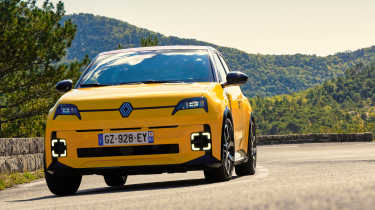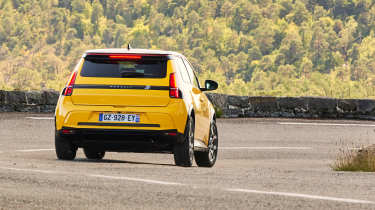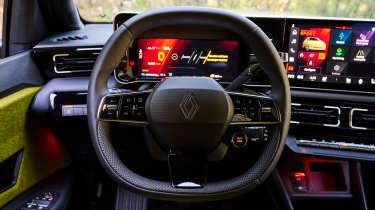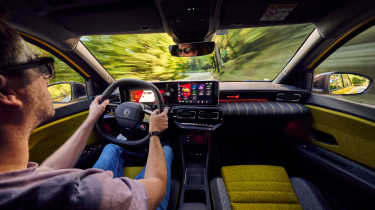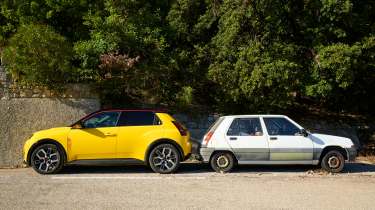Renault 5 2025 review - £23k fun electric hatch with some of the original's spirit
Retro EVs aren't in short supply but Renault has pulled-off the transition better than most with its electric 5
Bright yellow and angular it may be, but calling the new Renault 5 E-Tech a supercar would be generous. It’s too tall, too short and too narrow, powers its front wheels, runs on electrons, and makes a mere 148bhp. No, the car we drove through Nice wasn’t the crazy rear-driven, 500bhp R5 Turbo 3E, nor the warmed-over Alpine A290. It was the standard Clio-sized (and priced) £23k family hatch. But for all the attention it got, it might as well have been something low-slung, mid-engined and thirsty for hydrocarbons.
The attention never stops. While we’re parked up for photography in the mountains, the driver of a Peugeot 208 passes with a huge smile on his face, then returns two minutes later and asks to have a look around. A couple of cyclists take a break from their arduous climb to do likewise. Later, the driver of a Porsche Taycan rushes up behind then whips out his phone for a few snaps, and further down the road a group of kids – young enough to know the Cinq only as a dilapidated old car from two decades before they were born – all point and wave. The latter is especially encouraging, given how often we’re told young people don’t care about cars.
More reviews
I cannot remember the last time so many people have pointed, stared, smiled, waved, complimented, and generally shown an interest in a car, let alone one the size of a Clio and ostensibly aimed at people who probably don’t read magazines like this one.
Maybe the interest will die down in the weeks and months ahead and the new 5’s visual fizz will diminish as buyers inevitably choose less vivid exterior hues and the cars become more common, but first impressions are that for the French at least, the 5 has the same impact BMW’s first Minis did in Great Britain circa 2001.
It’s also quite some time since I’ve driven a car that its own manufacturer is so excited by. Sure, executives and designers and PR folk are always externally enthusiastic about their new products, but the impression positively radiating from those at Renault is that they’ve loved being involved with this project, and that they can’t wait to unleash it on the world. There’s genuine pride here, and the feeling that they’ve created something because they wanted to, rather than simply to fill a niche or steal a handful of sales from a competitor.
In many ways the new 5 is entirely conventional. It’s a shade under four metres long, making it shorter than a modern Clio (for a more familiar frame of reference, it’s nigh-identical in width to an old Renault Sport Clio 197, a couple of inches shorter, and an inch taller), has five doors, and four-and-a-bit seats. It sits on an all-new platform, called AmpR, and uses conventional steel construction, though use of multi-link rear suspension is a notch more sophisticated than most B-segment cars.
As tested in top-spec E-Tech 150 Iconic trim (£29k), it has a 148bhp motor driving the front wheels, a 52kWh battery pack slung underneath for a 252-mile WLTP range, and tips the scales at a chunky-for-a-supermini but not-bad-for-an-EV 1456kg. A current hybrid Clio E-Tech comes in at 1323kg, so in some respects the usual EV bloat hasn’t made a huge difference, though it’s not a kerb weight, nor a power-to-weight ratio at around 100bhp/tonne, likely to get Jean Ragnotti hot under the collar.
> The 500bhp Renault 5 Turbo 3E is a rally icon revived
We don’t usually dwell on aesthetics, but given the splash it’s made among the locals, and given it’s sure to be one of the reasons people will buy the 5 over other electrified superminis, it’s probably worth at least a paragraph or two. To these eyes it looks fabulous, more hot-hatch than most actual hot hatches, and even better in the metal than in pictures. Renault’s keen not to call it a retro design, and while it obviously draws inspiration from its 1970s-1990s namesake, you could strip away all the historical baggage and still be staring at a sharp, distinctive and exquisitely detailed shape in its own right.
Retro references include the basic trapezoidal shape common to all 5s, a hint of the old car’s rectangular headlamps in the new car’s lights, and the vertically mounted tail lights. Then there are the flared arches, square daytime running lights in the bumper, and an up-and-over detail around the roof that respectively nod to the 5 Turbo’s box arches, fog lights and roof spoiler. Squint a bit and you could call the hidden rear door handle a throwback to the original car’s inset handles too. You can get the new 5 in black or white, but you’ll be doing the world a disservice if you don’t opt for this car’s Pop Yellow, the similarly vivid Pop Green, or the Renault Clio Williams-style Midnight Blue.
The vibrancy continues inside. Our top-spec test car gets closest to the designer’s ideal with yellow recycled fabric and yellow piping and stitching splashed across the seats, door cards and dash. The seats are absolutely fabulous, looking like a modern interpretation of the mad, Gandini-designed 5 Turbo buckets, with prominent bolsters (a feature across the range, and something the old Renault brochures once proudly boasted as having a Petale design) and an H-shaped graphic also referencing the seats in the Turbo.
A blocky digital instrument and Google-based infotainment display is hardly novel in 2024 but could be considered a callback to the Turbo’s dash pod, though the original never got a ChatGPT-powered digital assistant called ‘Reno’ – which we assume is pronounced as per the actor from Ronin, but with the infotainment set to English, introduces itself like the city in Nevada. The padded area in front of the passenger (leatherette here, a denim-style material on other trims) is a more direct reference to the original’s ridged dashboard, and if you’re being generous, the steering column-mounted gear selector (which can be personalised with various 3D-printed designs) might be called a descendent of the earliest 5’s dashboard-mounted gear lever.
Even ignoring the look, first impressions are pretty good. You feel a little perched even with the seat adjusted low, but that’s been a feature of Renault hatches, hot or otherwise, for a while. But the seats are supportive, the fabric feels great, and good height and reach adjustment for the wheel ensures there’s no bother finding a decent driving position, though with the seat set for my 5ft 8in, space for those behind is already getting tight. That column-mounted shifter makes the right-hand side of the wheel feel a touch busy, and more than once I set the wipers to full monsoon rather than selecting Drive. But, being an EV, this is about the extent of your interaction with it.
Perhaps because the Five is front-drive only, Renault has programmed some build-up into the way it steps off the mark. There’s not the neck-snap you get from some electric cars, but there’s enough torque to give your hands something to do if you accelerate hard from rest or out of a tight corner. It’ll spin its wheels on damp surfaces, or out of junctions and hairpins too, so it has its moments of hot-hatch yobbery, and feels good for its claimed eight-second 0-62mph time.
There’s a little dial on the wheel labelled ‘Multi Sense’ and this is your driving mode selector. Cycling between Normal, Eco, Sport and ‘Perso’ does the usual things: with no active dampers and no sound generator that I could find, it’s effectively limited to changing steering weight, accelerator response, and – in Eco mode – pegging back the air-conditioning, power and top speed to save energy.
After about ninety seconds in Normal I switched it to Sport and left it there for the duration of the launch event (it’ll stay in your chosen mode if you turn the car off and return to it later), as it makes the low-end acceleration a touch more responsive while the extra steering weight is welcome. Plus, being an electric car, Sport doesn’t mean the car will bellow brainlessly through villages at 6000rpm in second gear as a dual-clutch hot hatch might.
The hills and mountains of the Côte d’Azur are a great place to exercise small hatches, and the 5 certainly gives it a go. The surprisingly taut but nicely damped ride feels promising, as does the stiff-feeling structure and minimal body roll. An exploratory wiggle of the steering suggests it’s keen but not as darty as a Mini, and the firmness of the brake pedal is also welcome – in fact, this is one EV where the integration of friction braking and regen at the pedal is arguably more intuitive and satisfying than the regenerative effect when you lift off in the ‘B’ transmission mode, which isn’t quite strong enough for one-pedal driving.
It’s also clear, punting the 5 through a few corners, that this is a car set up primarily to be safe and predictable. Traction control and ESP intervention isn’t severe but even when you switch it off (just a few prods of the touchscreen menu) and employ the time-honoured hot-hatch cornering technique of ‘bung it in and lift off’ the result is more a steady four-wheel drift than anything that needs steering correction or balancing with the right-hand pedal.
But other than the slightly disconcerting EV sensation of being able to hear the tyres scrubbing around on the asphalt, the 5 still meets you halfway on these roads. Grip from the relatively narrow (195-section) and not especially sticky (Continental EcoContact 6Q) tyres is perfectly decent and the low-feedback but well-weighted and sensibly geared steering, smooth powertrain and tied-down chassis mean it’s easy to get into a satisfying flow.
The 5’s weight means it never feels quite as agile as a lighter hatch, and the mass can also catch out the suspension over certain undulations where it takes longer to settle, but conversely the positive brakes and the feeling that it won’t bite if you take a few liberties means you can also, for instance, give a convoy of Swiss Porsche owners a bit of a hard time through a series of hairpins and twists.
Price and rivals
For the new 5, the key competitor must surely be the now-electric Mini Cooper E, along with others including the Fiat 500e, Peugeot E-208, and Vauxhall Corsa Electric. It’s a bit of a motley assortment, but common themes include pricing that stretches from £22,995 basic to £28,995 for a 148bhp 'iconic five' like we've sampled here, supermini dimensions, and a real-world range of between 150 and 200 miles depending on battery size.
Still, it’s not a hot hatchback and isn’t being marketed as one. Renault has left the door wide open for the 217bhp Alpine A290 in that respect, and if the 5 feels a little too mild, another seventy horses and a chassis tuned with slightly more adjustability in mind should go some way to fixing that. What you do get with the 5 E-Tech is an immensely likeable electric hatch that drives better than it needs to, will cover a real-world 200 miles on a charge and, for the time being at least, turns more heads than a supercar.
| Motor | Single e-motor, front-wheel drive |
|---|---|
| Power | 148bhp |
| Torque | 181lb ft |
| Weight | 1456kg (103bhp/ton) |
| Tyres | Continental EcoContact 6Q |
| 0-62mph | 8.0sec |
| Top speed | 93mph |
| Basic price | £22,995 |

